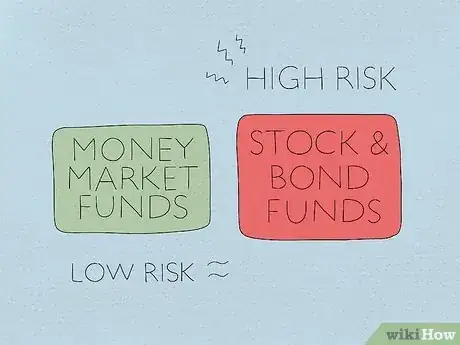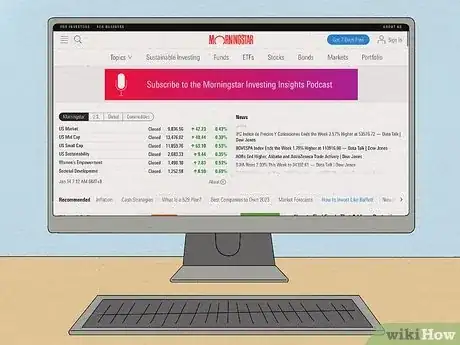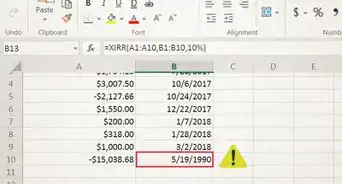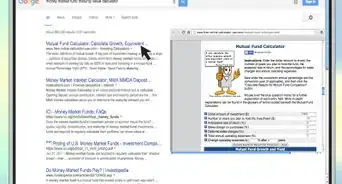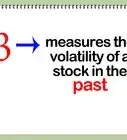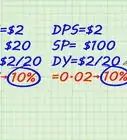This article was co-authored by Dmitriy Fomichenko and by wikiHow staff writer, Jennifer Mueller, JD. Dmitriy Fomichenko is the president of Sense Financial Services LLC, a boutique financial firm specializing in self-directed retirement accounts with checkbook control based in Orange County, California. With over 19 years of financial planning and advising experience, Dmitry assists and educates thousands of individuals on how to use self-directed IRA and Solo 401k to invest in alternative assets. He is the author of the book "IRA Makeover" and is a licensed California real estate broker.
There are 7 references cited in this article, which can be found at the bottom of the page.
wikiHow marks an article as reader-approved once it receives enough positive feedback. In this case, several readers have written to tell us that this article was helpful to them, earning it our reader-approved status.
This article has been viewed 83,610 times.
In addition to investing in individual stocks and bonds, American investors also have the option of using mutual funds to save for retirement and other longer-term savings goals. While mutual funds aren't the best choice for short-term traders, mutual fund holdings can help you diversify your investments while maintaining a low cost structure and a focused investment target. If you want to invest in mutual funds, take time to research and choose your fund wisely.[1]
Steps
Developing Your Investment Strategy
-
1Determine your risk tolerance. There are several different types of mutual funds available, each of which has a different level of risk. Even if you are a relatively conservative investor, you still may want to add one or two higher-risk funds.[2]
- A diversified basket of mutual funds that meets your overall preferred level of risk allows your portfolio to experience some growth rather than merely preserving your capital.
- Within your overall investment account, you want to reserve at least 5 percent of your assets in cash so you can take advantage of opportunities as they arise.
- Money market funds generally have the lowest risk level. Stock funds and bond funds are generally higher risk funds. Target date funds carry a mix of investments and are best if you have a specific retirement date in mind.
-
2Research the market. Before you start buying shares in mutual funds, you need a good understanding of the types of funds available, the possible returns associated with those funds, and the expenses involved.
- You can learn a lot about mutual funds by reading on the internet, especially at the website of the U.S. Securities and Exchange Commission (SEC), which regulates mutual funds.
- You also can download a complete consumer guide to mutual funds at https://investor.gov, which will walk you through all the details of the market generally and provide guidance on investing wisely.
Advertisement -
3Visit financial websites. Online ratings services, such as Lipper or Morningstar, offer risk assessments for each mutual fund. Compare these to the risk tolerance you've established to decide which mutual fund is right for you.[3]
- These services also detail all fees and charges related to each mutual fund. These expenses can eat into your returns significantly, so you need to research each fund carefully before you commit any money.
- Look beyond the name of a fund. Just because a fund carries the name of a particular bank may not mean that bank still runs that fund. A fund called a "stock fund" may carry other investments besides corporate stock.
-
4Choose an active or passive investment strategy. While investing in an actively-managed fund will give you more flexibility, you likely will pay higher fees to an investment manager. Passive investment in index-based funds may be a better option for you if you are new to investing.[4]
- Investing in index mutual funds is typically considered a safe and easy way to get into investments.[5]
- Index-based funds typically have lower fees than actively-managed funds, but they also run the risk of underperforming once you take fees and taxes into account.
-
5Decide how long you plan to hold your investments. Generally, investing in mutual funds will be more satisfying if you plan to hold your shares for five years or longer. The longer you hold your shares, the better your chance of a decent investment return.[6]
- Some funds offer several different share classes, typically A, B, and C classes. Each class has a different fee structure. The length of time you plan to hold your shares can help you determine which share class is most appropriate for you.
Choosing the Right Mutual Funds
-
1Bypass brokers. While it might seem easier to use a broker to find the right mutual funds for you, doing so can cost you significantly in brokerage fees. If you buy and sell shares directly through fund companies, you can avoid these fees.[7]
- Especially if you are a beginning investor, you may feel more comfortable with the advice and guidance of an experienced broker. However, you can get similar advice for free from advisors who work for the mutual fund company you choose.
-
2Minimize fees. Some mutual fund companies charge sales and redemption fees (known as "loads"). Others may charge a "12b-1" fee to defray marketing expenses. It is possible to avoid both of these fees by picking your mutual funds wisely.[8]
- The "expense ratio" charge, on the other hand, is unavoidable. This fee goes to pay for company overhead. Choose a fund that charges an expense ratio of 1 percent or less.
- Keep in mind that a fund that charges higher fees must significantly out-perform a fund with lower fees for you to realize the same return. Generally, it's wisest to go with the fund that has lower fees.[9]
-
3Evaluate tax consequences. If you previously invested in individual stocks or bonds, you may know that you don't have to pay any capital gains tax unless you sell your stocks or bonds and make a profit. However, if you invest in a mutual fund you must pay taxes on the fund's capital gains.[10]
- To minimize capital gains taxes, look for mutual funds with relatively low turnover ratios. Since these funds hold their stocks and bonds for a long time, they generate less capital gains and losses.
- If you want to keep your tax consequences low, look for a tax-managed fund. These types of funds are specifically designed to minimize your capital gains tax burden as much as possible.[11]
-
4Read the prospectus. While a fund's prospectus can be an intimidating document, it also contains important information about the fund's investment objectives, history, and performance. The prospectus also explains the risks of the fund and fees and expenses associated with it.[12]
- Study the prospectus carefully before you purchase any shares in the fund. If you have any questions, the fund company typically will have advisors available to assist you.
-
5Practice overall diversification. Diversification is essential for performance success. By their nature, mutual funds are more diversified than investing in a few individual stocks or bonds. You can further diversity your portfolio by buying shares in several funds with various styles and profiles.[13]
- Your fund portfolio has the best chance of long-term success if you diversify across a number of unrelated asset classes. This could include domestic or international stocks or bonds, commodities, and other sectors of the economy such as utilities, real estate, precious metals, energy, biotechnology, medicine and finance.
- Spreading your money across asset classes means downward movement in one particular industry won't have a significant negative impact on your portfolio.
-
6Avoid trying to "time" the market. Even the most experienced investor can't predict the future. Buying into a high-quality mutual fund and holding it for years is the best road to investing success.[14]
- Don't worry too much about short-term fluctuations. Pick funds with good histories and stick with them over the long haul.
- Short-term returns of less than a year or two can be distracting and misleading. Base your choice on returns from the past ten years or longer to accurately assess the quality of the fund.
- Keep in mind that even experienced investors can fall victim to "performance chasing," in which they read about high-performing funds and move on them quickly. Mutual fund investing requires patience. Understand that past performance is no predictor of future performance.
-
7Select a financial institution to purchase mutual funds. While independent research is important, if you have friends or family members who regularly invest in the market, you also might want to ask them for advice or recommendations.[15]
- Online investment firms typically have competitive fee structures and varied fund selections for investors willing to take a do-it-yourself approach to investing in mutual funds. You must carefully monitor the performance and allocation of your mutual fund holdings yourself. However, most online investment management firms have tools and guidance sections to help beginners.[16]
- You may prefer the guidance of a professional if you have a more sizable portfolio. Look for a fee-only financial advisor who can alleviate the burden of self-selecting and monitoring the mutual funds in your various accounts.
- Keep in mind that while banks and credit unions offer access to mutual funds, they may charge higher fees or commissions and have a more limited selection of funds. You also should remember that a bank's mutual fund is not a bank deposit and is not FDIC-insured.[17]
Managing Your Investments
-
1Rebalance your portfolio every year. When you get your year-end statements in January, take a look at the performance of your mutual funds and rearrange your investments by buying and selling shares. This allows you to retain your original balance.
- For example, suppose you have $100,000 which you have spread evenly across four different funds. However, at the end of the year, one fund has out-performed the rest so that it is now 30 percent of your portfolio rather than 25 percent. To rebalance your portfolio, you would want to take 5 percent of your shares in that fund and transfer them to the other funds in your portfolio.
- If your funds are held in a tax-deferred account such as a 401k, transferring assets between funds typically is your best option. However, with taxable accounts it's generally better to simply add new contributions to the lower-performing funds to rebalance. This way you can avoid paying taxes on the assets you sell and transfer.
-
2Practice performance weighting. Performance weighting is a rebalancing strategy that involves selling shares from a high-performing fund and buying shares in your lowest-performing fund. While it seems counterintuitive, it follows the principal that funds tend to bounce back.[18]
- You can think of this as adhering to the general stock investment strategy of buying low and selling high. You typically can buy more shares in a lower-performing fund, so you'll realize a greater return when it bounces back.
- Rebalancing your portfolio in this way will put you further ahead in the long-term than other strategies.
-
3Take a disciplined approach. When investing in mutual funds, discipline and self-control are important for healthy long-term returns. If you are impatient and trade frequently, chasing high-performance funds and large gains, you end up costing yourself a lot of money.[19]
- Ultimately, anyone can be a successful investor, and mutual funds are a great investment vehicle for beginning investors. However, you must have a plan to invest and the discipline to stick to that plan.
- Avoid making decisions based on emotions or out of desperation. If you are questioning your motives for making an investment decision, talk to an advisor who can be objective.
-
4Replace under-performing funds. Typically, mutual funds will bounce back from a downturn, so it's not necessarily a good strategy to dump a mutual fund just because it performs poorly in the short-term. However, If a fund has taken an overall downward trend for awhile, it may be time to let it go.[20]
- You also should watch out for funds that change managers, especially if this happens suddenly. Different managers may have different strategies that could significantly affect performance.
- Be on the lookout for changes that mean the fund at present has changed character so much that it's no longer the same fund in which you originally invested. Replace it with a fund that more closely matches your original goal for that fund within your portfolio.
Expert Q&A
-
QuestionShould I invest in mutual funds?
 Dmitriy FomichenkoDmitriy Fomichenko is the president of Sense Financial Services LLC, a boutique financial firm specializing in self-directed retirement accounts with checkbook control based in Orange County, California. With over 19 years of financial planning and advising experience, Dmitry assists and educates thousands of individuals on how to use self-directed IRA and Solo 401k to invest in alternative assets. He is the author of the book "IRA Makeover" and is a licensed California real estate broker.
Dmitriy FomichenkoDmitriy Fomichenko is the president of Sense Financial Services LLC, a boutique financial firm specializing in self-directed retirement accounts with checkbook control based in Orange County, California. With over 19 years of financial planning and advising experience, Dmitry assists and educates thousands of individuals on how to use self-directed IRA and Solo 401k to invest in alternative assets. He is the author of the book "IRA Makeover" and is a licensed California real estate broker.
Financial Planner Personally, I do have a small portion of my portfolio invested in index mutual funds. It's probably the safest and easiest way to invest. However, it's best to just invest and leave it alone—I don't really worry about checking it often or making adjustments.
Personally, I do have a small portion of my portfolio invested in index mutual funds. It's probably the safest and easiest way to invest. However, it's best to just invest and leave it alone—I don't really worry about checking it often or making adjustments.
References
- ↑ https://www.sec.gov/reportspubs/investor-publications/investorpubsinwsmfhtm.html
- ↑ https://investor.gov/investing-basics/investment-products/mutual-funds
- ↑ https://www.sec.gov/reportspubs/investor-publications/investorpubsinwsmfhtm.html
- ↑ https://www.sec.gov/reportspubs/investor-publications/investorpubsinwsmfhtm.html
- ↑ Dmitriy Fomichenko. Financial Planner. Expert Interview. 30 June 2020.
- ↑ https://www.sec.gov/reportspubs/investor-publications/investorpubsinwsmfhtm.html
- ↑ http://guides.wsj.com/personal-finance/investing/how-to-buy-a-mutual-fund/
- ↑ https://www.sec.gov/reportspubs/investor-publications/investorpubsinwsmfhtm.html
- ↑ https://investor.gov/investing-basics/investment-products/mutual-funds
- ↑ https://www.sec.gov/reportspubs/investor-publications/investorpubsinwsmfhtm.html
- ↑ http://guides.wsj.com/personal-finance/investing/how-to-buy-a-mutual-fund/
- ↑ https://investor.gov/investing-basics/investment-products/mutual-funds
- ↑ https://investor.gov/investing-basics/investment-products/mutual-funds
- ↑ http://guides.wsj.com/personal-finance/investing/how-to-buy-a-mutual-fund/
- ↑ https://www.sec.gov/reportspubs/investor-publications/investorpubsinwsmfhtm.html
- ↑ https://investor.vanguard.com/mutual-funds/
- ↑ https://www.sec.gov/reportspubs/investor-publications/investorpubsinwsmfhtm.html
- ↑ http://www.investopedia.com/articles/mutualfund/082802.asp
- ↑ http://www.investopedia.com/articles/mutualfund/082802.asp
- ↑ http://www.kiplinger.com/article/investing/T041-C000-S001-time-to-ditch-your-fund.html
About This Article
To invest in the market, develop a strategy by going online to the U.S. Securities and Exchange Commission website for general information, and websites for online rating services, like Morningstar, for specifics. When you’ve decided on a strategy, choose the “right” mutual funds for your portfolio, and make sure to read their prospectuses and carefully consider any fees and tax consequences. Ready to buy? Avoid brokers and their big fees and invest directly in the funds or through a trusted financial institution. If you want to learn how to rebalance your portfolio each year, keep reading the article!
